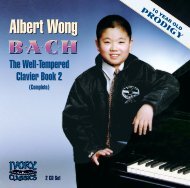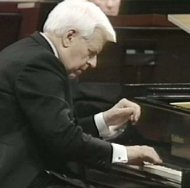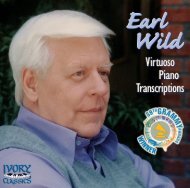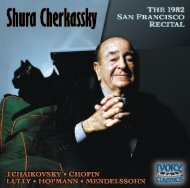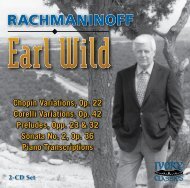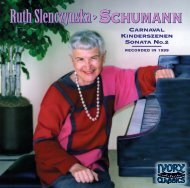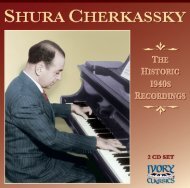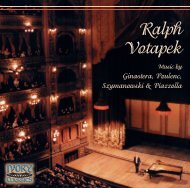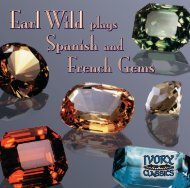70806 for PDF 11/05 - Ivory Classics
70806 for PDF 11/05 - Ivory Classics
70806 for PDF 11/05 - Ivory Classics
Create successful ePaper yourself
Turn your PDF publications into a flip-book with our unique Google optimized e-Paper software.
Franz Joseph Haydn<br />
Nadia Reisenberg<br />
The Acclaimed Haydn Recordings (2 CD Set)<br />
Haydn’s Piano Works<br />
“I acknowledge with pleasure the desire of many<br />
music lovers to own a complete edition of my piano<br />
compositions,” wrote Franz Joseph Haydn in 1799,<br />
“and I shall see to it that in this collection no work<br />
which wrongly bears my name will be included.”<br />
The collection he referred to was subsequently published<br />
in twelve volumes, between 1800 and 1806<br />
under the enticing, if erroneous title “Oeuvres completes.”<br />
Actually, Haydn was the chief culprit in that<br />
misnomer, since by his own admission, he not only<br />
removed spurious compositions, but deleted as well<br />
“those works of my early youth which are not worth<br />
preserving.”<br />
Later generations, of course, were not at all ready<br />
to discard any of the master’s works so cavalierly, and<br />
the number of Sonatas which indeed comprise<br />
Haydn’s “complete works” has been revised upwards<br />
on several occasions. The original 1800-06 edition contained thirty-four piano sonatas. A collection<br />
edited by Hugo Riemann, and published in London in 1895, added five more. In 1918, the<br />
now standard Karl Päsler edition listed fifty-two sonatas. Nor is the accounting yet complete: in<br />
1966, a newly published Vienna Urtext edition has upped the total again to sixty-two (including a<br />
fragment of a sonata previously considered lost, and several scores freshly discovered in Viennese<br />
and Moravian archives). The miscellaneous pieces by Haydn did not fare as well. Many were lost<br />
and less than twenty works are extant. Of these, Nadia Reisenberg’s recital assembles four sets of<br />
variations and two superb miniatures – the Fantasia and the Capriccio – on which alone Haydn’s<br />
reputation as a piano composer could safely rest.<br />
Since Haydn considered his keyboard sonatas to be among his minor compositions, he took<br />
little care to document them <strong>for</strong> posterity. The Sonata No.13 in G Major (Hob.XVI:6) was<br />
– 2 –
published with five other sonatas in 1766 when the composer was thirty-four years old and in the<br />
service of Prince Nicholas Esterhazy. The Sonata No.13 in G Major, <strong>for</strong> Haydn still an early work,<br />
follows the style current in Vienna in the middle seventeen hundreds. In some editions it is entitled<br />
“Partita” and in others “Divertimento.” The opening Allegro presents three melodies in succession<br />
accompanied congenially by the left hand; it could well be considered as a violin solo with clavier<br />
accompaniment and, in fact, Haydn arranged many of his keyboard sonatas <strong>for</strong> that combination.<br />
The second movement is a graceful Minuetto with a central Trio in the minor; the minuet was<br />
always a favorite of Haydn’s and, although he later speeded it up to almost scherzo proportions, in<br />
this early sonata it still maintains the gallant rhythms of the dance. The Adagio which follows<br />
reminds one of a Bach Arioso: a slow ornate melody above chords. The sonata ends with a fourth<br />
movement – Allegro molto – in two parts, each repeated in the manner of Scarlatti.<br />
The Fantasia in C Major (Hob.XVII:4), composed in 1789, in some editions is also called<br />
“Capriccio.” Biographer Rosemary Hughes calls this work “bewilderingly free in structure,” while<br />
Karl Geiringer could “hear in this piece the tone of violins and double basses, of horns and flutes;<br />
moreover a rapid crossing of the hands, the arpeggios, and the distribution of passages between the<br />
two hands exhibit the composer’s concern <strong>for</strong> purely pianistic devices. The effect that Haydn<br />
achieved by holding notes in the bass until they die away (tenuto intanto finche non si pente più il<br />
sono) is rather notable. This fantasia was written by a master who exploited the possibilities of piano<br />
technique in transcribing ideas of an essentially orchestral nature.” The marking is simply Presto.<br />
After an interval in B flat there are two long stretches of profligate modulation around a central section<br />
in A. The prodigal C comes home abruptly, and with even more telling effect than it had made<br />
in taking leave many pages earlier.<br />
The Sonata No.62 in E-flat Major (Hob.XVI:52) was composed in 1794. It affirms its stature<br />
with the very opening chords – dramatic punctuations that set the stage <strong>for</strong> an unraveling of music<br />
in the grand style. This is, perhaps the most adventurous of all of the sonatas – with its extraordinary<br />
harmonic design, its <strong>for</strong>ays into near-romantic expressionism, its nobility of spirit. Its key relationships<br />
are remarkable, not only in terms of the striking modulations within movements, but also<br />
in the fact that the middle Adagio is daringly cast in E major – poles apart, harmonically speaking,<br />
from the outer movements in E flat. This slow movement stands as well among the loftiest examples<br />
of Haydn’s art – it contains music of grandeur, profundity and extraordinary warmth. By contrast,<br />
the Finale is a whirlwind Presto, brimming over with elan and that zesty impertinence which<br />
marks Haydn at his most ingratiating.<br />
The Tema con Variazioni in C Major (Hob.XVII:5) of 1791 permits itself a modicum<br />
– 3 –
of temerity. The dolce theme, restrained and lovely, is set<br />
<strong>for</strong>th Andante. In the first four chapters that follow, the story<br />
does not change harmonically. With Variation V we are<br />
plunged suddenly into the dark waters of C minor, thence to<br />
E flat, and so <strong>for</strong>th until, at the end, we find ourselves poised<br />
in G. Variation VI, not unnaturally, is strongly tonic. The<br />
great innovator is not ashamed to give the last word to a C<br />
major chord.<br />
The Sonata No.50 in D Major (Hob. XVI:37), published<br />
in 1780, is a highly expressive work. By 1780 Haydn had<br />
acquired an international reputation. The King of Spain had<br />
sent him a jewelled snuffbox, Lord Abingdon urged him to<br />
visit England <strong>for</strong> a season, Ferdinand IV of Naples desired to<br />
see him in Italy, and the future Empress of Russia insisted<br />
that he instruct her in singing. Haydn, however, was hampered<br />
absolutely by his position with Prince Esterhazy, who<br />
Nadia Reisenberg, 1920s had no intention of allowing his Kapellmeister to leave his<br />
estate to entertain anyone else. The most that Haydn was<br />
granted were occasional short visits to Vienna where he was heralded by an intrigued group of lower<br />
nobility and wealthy middle class patrons, among whom were the sisters Auenbrugger. It was <strong>for</strong><br />
these ladies that Haydn wrote his Sonata No.50 in D Major. Concerning the sisters he wrote to his<br />
publisher Artaria: “The approval of the Misses von Auenbrugger is most important to me, because<br />
both their technique and their genuine understanding of the art of music are equal to the greatest<br />
masters’. Both deserve to become known throughout Europe by music published in their honor.”<br />
The sonata is constructed in three movements. The first, Allegro con brio, light and rapid as it is,<br />
progresses by changes in mood rather than by the introduction of new material. The music is unified<br />
and seems to belong on the piano. The middle Largo is rather like a sarabande and one of the<br />
most unsettled slow movements in the writing of a composer who was famous <strong>for</strong> his moving adagios.<br />
The mood is intensified by the absence of a pause be<strong>for</strong>e the final Presto: a good-humored<br />
movement, but by no means merely showy.<br />
The Arietta con Variazioni in A Major (Hob.XVII:2) dates from 1771. It has come down to us<br />
with nineteen variations, although the Haydn-Elssler thematic index lists twenty, the Oeuvres completes<br />
eighteen, and Artaria only twelve. The Landesbibliothek in Weimar has a score with twenty,<br />
– 4 –
ut not including the No.10 in the Artaria sequence; the minimum total of variations composed is<br />
there<strong>for</strong>e twenty-one. Nineteen is today accepted as standard, however, two having been killed by<br />
the composer according to scholarly consensus. Stylistically the work tends to simulate the gracefully<br />
galant manner of Carl Philipp Emanuel Bach, who was Haydn’s hero-prototype. The dulcet,<br />
folk-like theme is announced Allegretto quasi Andantino. At no time from then <strong>for</strong>ward is there any<br />
departing the tonic. Several of the variations are especially delightful: III <strong>for</strong> its darting sixteenth<br />
patterns, V <strong>for</strong> its crossed-hands cleverness, VIII <strong>for</strong> its elfin scherzando character, X <strong>for</strong> its fantastic<br />
prophecy of Petrouchka, XI <strong>for</strong> its canonic by-play, XV <strong>for</strong> its feathery leggierro, the usually missing<br />
XVII <strong>for</strong> its minuetishly Mozartean ways, the final XIX <strong>for</strong> its Ländler charm.<br />
The Sonata No.53 in e minor (Hob.XVI:34) is dated January 15, 1784. Haydn was then under<br />
the spell of a then new, mostly literary, movement known as Sturm und Drang. (The official translation<br />
of this term is “Storm and Stress,” however, a perhaps better translation of this term might<br />
be “Storm and Urge”.) The language of the opening movement, marked Presto, gives us a glimpse<br />
into the future, music that is hovering over the borderline which separates the Here from the<br />
Beyond, the darkness, the brooding, the questioning, and in the second movement (Adagio ) the<br />
long and lonely meditation. The last movement (Molto vivace) is, on the strength of its theme alone,<br />
one continued urging question, gaining in urgency as it speeds along. The closing phrases of this<br />
movement, reveal Haydn as the unerring – still classical – master of equilibrium. Their sheer gracefulness<br />
seems to turn the entire question into a lofty play, so that the work’s final chord releases us<br />
with a smile.<br />
The Capriccio in G Major (“Acht Sauschneider müssen sein”) (Hob.XVII:1) is a longish rondo,<br />
originally written in 1765. It reappeared in 1788 with a designation of Opus 43. A year later, Haydn<br />
wrote to his publisher Artaria that “I have composed an entirely new capriccio <strong>for</strong> the piano; its<br />
good taste, singularity, and elaborate finish are sure to please.” Supposedly, this third (?) version was<br />
then brought out, but, today, the only autograph manuscript unearthed thus far is the 1765 version.<br />
The work is in a single movement, marked Moderato. Thematically, it was derived from a<br />
North German folksong, which Haydn refined to a sort of minuet be<strong>for</strong>e proceeding with it in D,<br />
A minor, F, and G minor. From all of these key changes it emerged quite unscathed <strong>for</strong> the <strong>for</strong>tissimo<br />
affirmation at the close.<br />
The Sonata No.35 in A flat Major (Hob.XVI:43), was written in 1783, when the master was 51<br />
years old. At that time Haydn was openly and avowedly taking in the inspirations and influences<br />
emanating from his colleague Wolfgang Amadeus Mozart. This period also shows Haydn predominantly<br />
at work on pieces of chamber music. The Sonata No.35 in A flat Major seems to be a case<br />
– 5 –
in point made by Haydn’s biographers, namely that it was<br />
primarily the charm of Mozart’s melodic lines which held<br />
Haydn spellbound. The entire work is an apotheosis of graceful<br />
gaiety – a beguiling cherub having a happy day. The first<br />
movement is a Moderato, and the second movement is not a<br />
slow one, but consists of a Minuetto I and a Minuetto II. The<br />
final movement, Rondo: Presto brings towards its close a note<br />
of actual teasing by substituting in the final statements of the<br />
Rondo theme the interval of an octave <strong>for</strong> the original interval<br />
of a fourth, and repeating this one high note as often as<br />
possible. All throughout the work, the economy of means<br />
and the transparency of texture make up so finely chiseled a<br />
tonal picture that we are indeed reminded of the technique of<br />
chamber music which happened to be the master’s main preoccupation<br />
at that time.<br />
With a lyrically dolce, broadly spaced theme stated<br />
Nadia Reisenberg, 1930s Moderato, the Arietta con Variazioni in E flat Major<br />
(Hob.XVII:3) of 1774 unfolds to a dozen neatly balanced<br />
mutations. As in the A major set, there is no harmonic adventure. It is as if Haydn had set out to<br />
demonstrate his powers of invention the hard way. That the work holds attention in the absence of<br />
modulatory diversions is simple proof of its success. Particularly arresting are the trilled-dotted<br />
rhythm of V, the busy scampering in VI, the ambivalently lyric-dramatic VII, the triplet figurations<br />
in VIII, and the give-and-take exchanges in XII that culminate in splendid agreement.<br />
The Sonata No.60 in C Major (Hob.XVI:50) is thought, by some musicologists, to be the last<br />
of Haydn’s works <strong>for</strong> solo piano, but it has been impossible to determine a positive chronology of<br />
the final three Sonatas. In any event, all three were written during the period 1794/5, and stand as<br />
masterful souvenirs of Haydn’s sojourn in London. They were evidently intended <strong>for</strong> per<strong>for</strong>mance<br />
by the pianist Theresa Jansen, at whose wedding to Gaetano Bartolozzi, in 1795, Haydn was a witness.<br />
The Sonata No.60 in C Major begins with a powerful Allegro. Expansive in concept, it ranges<br />
from dramatic sections to pages of the utmost brilliance. The fragile, tinkly approach to Haydn simply<br />
will not work here – the per<strong>for</strong>mer must complement the inherent energy of the score, bring<br />
out its assurance and vitality. The middle Adagio, cast in rather free, fantasia <strong>for</strong>m, it glows<br />
with themes of the most uplifting nature. Apparently, this movement was composed in Vienna a<br />
– 6 –
few years earlier and published as a separate Adagio in F. With the final movement (Allegro molto)<br />
we have a return to the tempo of the opening movement, but here the drama gives way to high spirited<br />
humor. Particularly effective are the amusing false starts and the unexpected modulations,<br />
devices that Haydn frequently favored in his mature symphonic works as well.<br />
Far and away the best known of Haydn smaller keyboard works is the Andante varié in f minor<br />
(Hob.XVII:6) of 1793. Haydn misleadingly called it a “piccolo divertimento scritto e composto per la<br />
stimatissima Signora Ployer.” This was the Barbara Ployer to whom Mozart dedicated his concerti<br />
K.449 and K.453; the Andante varié is no less a “trifle.” Ernest Hutcheson deems it “a model of<br />
classic style.” Foreshadowing the slow movement of the Beethoven Ninth there is a double theme,<br />
alternately in major and minor, with two omnibus variations. The recapitulation is “interrupted”<br />
by the stunning coda. Haydn’s biographer, Karl Geiringer, is not reluctant to classify this as “an<br />
important work,” and he perceptively detects in its aspects of color and harmony the “first beginnings”<br />
of romantic style.<br />
<br />
Nadia Reisenberg Biography<br />
Nadia Reisenberg was born in Vilnius, Lithuania, on July 14, 1904. On the occasion of the<br />
50th anniversary of her American debut, she reminisced: “I didn’t begin playing until the age of six,<br />
<strong>for</strong> the excellent reason that we didn’t have a piano. But then one arrived as a present from a favorite<br />
uncle, and it soon became clear that I would be at a keyboard <strong>for</strong> the rest of my life. My parents<br />
moved to St. Petersburg just so I could study at the Conservatory there, and when I was twelve I<br />
began studying with Leonid Nikolaev. Almost everything I know about the physical side of pianoplaying,<br />
I owe to Nikolaev’s extremely detailed schooling. He gave me that which has served me in<br />
all the years since.”<br />
The Russian Revolution came, and the Reisenberg family left Russia, traveling to Warsaw<br />
(where Nadia made her orchestral debut at the same concert where a young conductor, Artur<br />
Rodzinski, was also making his <strong>for</strong>mal debut), London, Berlin, and, in 1922, moving permanently<br />
to New York. She became a pupil of Alexander Lambert (himself a student of Franz Liszt), and<br />
later, also studied with Josef Hofmann at the Curtis Institute of Music. “From Hofmann I got<br />
a PhD in beautiful, sensitive pedalling, something that far too many pianists neglect these days,”<br />
she remembered.<br />
– 7 –
She gave her first American recital at the Aeolian Hall in<br />
New York in 1924, be<strong>for</strong>e an audience that included<br />
Hofmann and Paderewski. Her program included works by<br />
Bach, Glazunov, Scriabin, Liszt, Debussy, Medtner,<br />
Rameau-Godowsky and Albéniz. The New York Times proclaimed<br />
her to be “a pianist of evidently rare musical nature,”<br />
while the New York Herald called her “a gifted player of brilliance<br />
and finish far beyond her years.” This auspicious<br />
debut began a major career that included solo tours, chamber<br />
concerts with the Budapest Quartet and many other<br />
ensembles, and appearances with most of the important<br />
orchestras. In the spring of 1937 she made a European tour,<br />
giving recitals and appearing with orchestras in most of the<br />
principal capitals. She was enthusiastically acclaimed in<br />
Vienna, Warsaw, Prague, Budapest, Helsinki, Stockholm,<br />
The Hague, Amsterdam and London. “She is an extraordinary<br />
pianist,” wrote the critic of the Vienna Neue Freie<br />
Nadia Reisenberg, 1950s<br />
Presse, “with a wonderful technique, a colorful touch capable<br />
of a wealth of nuances and a beautiful and warm singing tone.”<br />
Upon her return to New York, she per<strong>for</strong>med frequently on radio. From November, 1938, to<br />
March, 1939, she appeared on live studio broadcasts over WOR in an historic series of all of the<br />
Mozart piano concerti conducted by Alfred Wallenstein. The broadcasts not only showcased the<br />
twenty-seven concertos [including the Concerto in E flat <strong>for</strong> 2 Pianos (K.365) and the Concerto in<br />
F <strong>for</strong> 3 Pianos (K.242) but also featured the two concert rondos, as well as the Johann Christian<br />
Bach sonatas arranged by Mozart (K.107)]. Reisenberg recalled: “It was the most rewarding experience<br />
of my entire career, my private year with Mozart! It took more than eight months to complete<br />
the programs, doing one concert per week, and since I had per<strong>for</strong>med only four or five of<br />
them be<strong>for</strong>e, I had to learn as I went along, and depend a great deal upon my intuition and innate<br />
taste. I always had six concertos on my piano at a time: I would be finishing two, working on another<br />
two, and reading through a third pair. But it was an invaluable experience, and one I will cherish<br />
<strong>for</strong> the rest of my life.” It was also a historic achievement, <strong>for</strong> although several attempts had been<br />
made be<strong>for</strong>e to play all the Mozart concerti in sequence, no one had done it again <strong>for</strong> nearly thirty<br />
years, until Lili Kraus’ marvelous concert cycle at Town Hall.<br />
– 8 –
During the next decade she continued to per<strong>for</strong>m a wide variety of concertos (Mischa<br />
Portnoff, Liszt No.2, Kabalevsky No.2, d’Indy, Prokofiev No.3, Rimsky-Korsakov, and others),<br />
and began to devote herself more fully to the two greatest musical joys in her life – chamber<br />
music and teaching. She appeared frequently with cellists Joseph Schuster and Leonard Rose, violinists<br />
William Kroll, Joseph Fuchs, Mishel Piastro and Georges Enesco, the Budapest String<br />
Quartet, and with Benny Goodman recorded the Brahms Sonata in E-flat Major. She remembered<br />
those days: “There is something wonderful about doing things together, and rarely do I<br />
experience the elation I find in chamber music. This is music-making in the purest sense, where<br />
the per<strong>for</strong>mer becomes humble, and far less important than the work being per<strong>for</strong>med. The sense<br />
of give-and-take, of listening, of being aware of all the sounds around you, all this lets you ripen<br />
into a better musician. That’s why I see to it that all my students play as much chamber music as<br />
possible.”<br />
She taught at the Curtis Institute of Music, was Visiting Professor of Music at the University of<br />
Southern Cali<strong>for</strong>nia, and guest lecturer at New York University. She also conducted master classes<br />
<strong>for</strong> pupils and teachers in Tulsa, Oklahoma, at the Rubin Academy of Music in Jerusalem, with the<br />
New Jersey Music Teachers Associations, and was on the faculties of the Mannes and Queens<br />
Colleges, as well as the Juilliard School, in New York City. In 1974 she remarked about the value<br />
of teaching: “It contributes enormously to one’s development as a musician to be able to analyze<br />
the problems of your students, even if they have never been your own problems. It’s fascinating to<br />
innovate ways of helping them, of building their potential without stifling their own personalities.<br />
I find teaching exciting, gratifying and rewarding, and it’s always been that way.”<br />
She continued her very active career to the very end, always committed to music. Her health<br />
failing, she died on Friday, June 10, 1983.<br />
These Westminster Haydn recordings, re-issued <strong>for</strong> the first time in their entirety, were recorded<br />
by Nadia Reisenberg during the years 1955 to 1958 and issued as three long-playing discs. When<br />
they were issued, the response from critics and listeners was unanimously ecstatic. The Detroit<br />
Sunday Times headed its review: “Haydn Album Great” and continued: “Beautifully per<strong>for</strong>med by<br />
Nadia Reisenberg... She has an unfaltering understanding of classical <strong>for</strong>m and spirit...” High<br />
Fidelity also praised her pianism: “No other Haydn record of the solo piano strikes the memory as<br />
comparable to this one in the precise mirroring of small piano-sound, or in the unruffled, obstinate<br />
refinement of the feathered filigrees whirled into a classic geometry by Miss Reisenberg.” Pianism<br />
of this stature and refinement is rare today, and we at <strong>Ivory</strong> <strong>Classics</strong> hope that a new generation<br />
of listeners will enjoy, once again, the artistry of this very special per<strong>for</strong>mer.<br />
– 9 –
– 10 –
Credits<br />
Recorded in New York, on August 1, 1955, December 18, 1956, and March 24, 1958.<br />
Originally released on 3 LPs on the Westminster label.<br />
(XWN 18<strong>05</strong>7, 18357, and 18358)<br />
Remastering Producer: Michael Rolland Davis<br />
High Resolution Digital Remastering:<br />
Ed Thompson and Glenn Meadows, Masterfonics, Nashville<br />
Special thanks to Donald Manildi, IPAM Curator, <strong>for</strong> his cooperation in this project.<br />
Released with the helpful assistance of Robert and Alexander Sherman.<br />
Liner Notes: From the original notes by James Lyons, Franzi Ascher,<br />
J. Robison, and Robert Sherman – edited by Marina and Victor Ledin<br />
Design: Communication Graphics<br />
Nadia Reisenberg Photos<br />
Cover: 1940s (by James Abresch) • Inside Tray: From her New York apartment balcony, 1970s<br />
Page 10: In her Juilliard studio, late 1970s (by Luigi Pellettieri)<br />
To place an order or to be included on mailing list:<br />
<strong>Ivory</strong> <strong>Classics</strong> <br />
P.O. Box 341068 • Columbus, Ohio 43234-1068<br />
Phone: 888-40-IVORY or 614-761-8709 • Fax: 614-761-9799<br />
e-mail@ivoryclassics.com • Website: www.<strong>Ivory</strong><strong>Classics</strong>.com<br />
– <strong>11</strong> –
Nadia Reisenberg<br />
The Acclaimed Haydn Recordings<br />
DISC #1<br />
Sonata No.13 (Partita/Divertimento) in G Major,<br />
Hob.XVI:6 (1766) 15:27<br />
I. Allegro 3:47<br />
II. Menuet - Trio 4:46<br />
3 III. Adagio 4:23<br />
4 IV. Finale: Allegro molto 2:31<br />
Fantasia (Capriccio) in C Major, Hob.XVII:4 (1789)<br />
5 Presto 6:10<br />
Sonata No.62 in E-flat Major, Hob.XVI:52 (1794) 20:57<br />
I. Allegro 8:28<br />
II. Adagio 6:59<br />
8 III. Finale: Presto 5:22<br />
Tema con Variazioni in C Major, Hob.XVII:5 (1791)<br />
Tema (Andante) and 6 Variations 3:47<br />
Sonata No.50 in D Major, Hob.XVI:37 (1780) 10:37<br />
I. Allegro con brio 4:17<br />
II. Largo e sostenuto 3:09<br />
III. Finale: Presto, ma non troppo 3:01<br />
Arietta con Variazioni in A Major, Hob.XVII:2 (1771)<br />
Arietta (Allegretto quasi Andantino)<br />
and 19 Variations 15:51<br />
Total Playing Time: 73:18<br />
1 2<br />
2 3<br />
6 6<br />
7 7<br />
9 8<br />
10 9<br />
<strong>11</strong> 10<br />
12 <strong>11</strong><br />
13 12<br />
DISC #2<br />
Sonata No.53 in e minor, Hob.XVI:34 (1784) 13:50<br />
1 I. Presto 3:54<br />
II. Adagio 6:46<br />
III. Vivace molto 3:10<br />
Capriccio in G Major (Acht Sauschneider müssen sein),<br />
Hob.XVII:1 (1765)<br />
4 Moderato 6:42<br />
Sonata No.35 in A-flat Major, Hob.XVI:43 (1783) 13:08<br />
5 I. Moderato 6:21<br />
II. Menuetto I and II 2:14<br />
III. Rondo: Presto 4:33<br />
Arietta con Variazioni in E-flat Major,<br />
Hob.XVII:3 (1774)<br />
Arietta (Moderato) and 12 Variations 7:15<br />
Sonata No.60 in C Major, Hob.XVI:50 (1794/5) 16:41<br />
I. Allegro 7:35<br />
II. Adagio 6:35<br />
III. Allegro molto 2:37<br />
Andante Varié in f minor, Hob.XVII:6 (1793)<br />
Andante, Variations and Coda 16:12<br />
Total Playing Time: 74:34<br />
Remastering Producer: Michael Rolland Davis<br />
2 CD SET<br />
High Resolution Digital Remastering: Ed Thompson & Glenn Meadows, Masterfonics, Nashville<br />
1998 <strong>Ivory</strong> <strong>Classics</strong> • All Rights Reserved.<br />
<strong>Ivory</strong> <strong>Classics</strong> • P.O. Box 341068<br />
Columbus, Ohio 43234-1068 U.S.A.<br />
Phone: 888-40-IVORY or 614-761-8709 • Fax: 614-761-9799<br />
e-mail@ivoryclassics.com • Website: www.<strong>Ivory</strong><strong>Classics</strong>.com<br />
644<strong>05</strong>-<strong>70806</strong><br />
®



